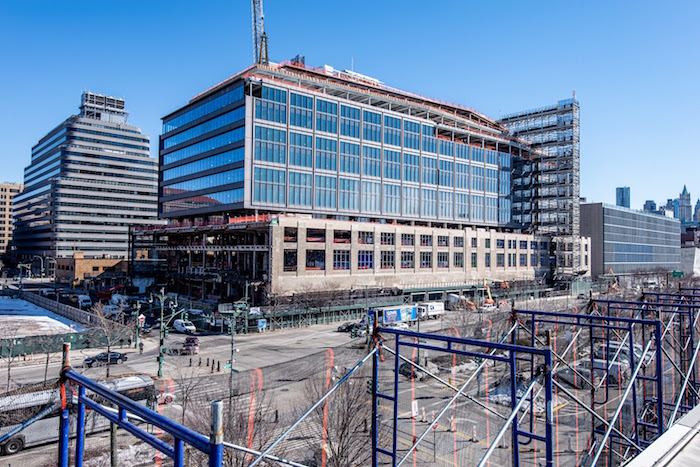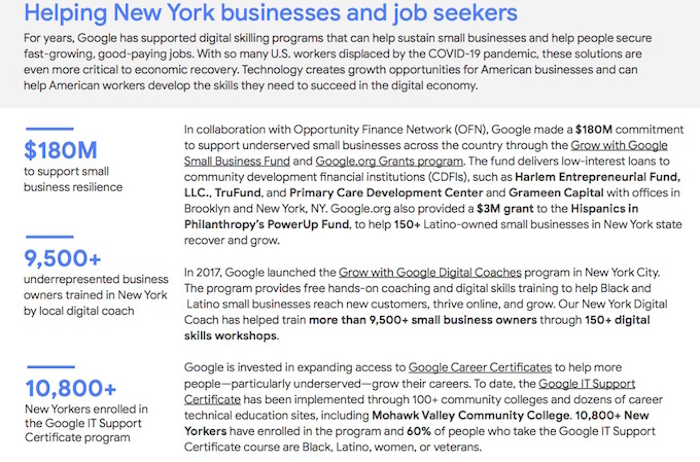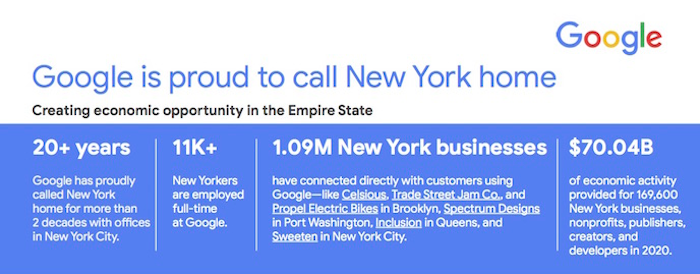
BY SCOTT STIFFLER | At the very same time the world was observing its first full year since COVID-19’s sheltering in place beget working from home, the company that made it desirable to do business in the digital realm was doubling down, and then some, on its post-pandemic brick and mortar presence. A March 18 press release announced Google’s commitment to “invest more than $250 million in New York throughout 2021. The investment includes continuing to build out Google’s campus presence in New York City. Nationally, Google also announced it plans to invest more than $7 billion and create at least 10,000 new full time Google jobs across the United States this year.”
For the company whose 20-year presence in NYC is distinguished locally by its 2018 purchase of Chelsea Market, and the location of its NYC headquarters (at 111 Eight Ave.), the announcement was also notable for confirming there will be a “long-term campus footprint in Manhattan, with an eventual 1.7 million square feet total office space in Hudson Square. The latest addition is the St. John’s Terminal at 550 Washington St., which topped-off in November 2020, and is expected to complete mid-2022 and be occupied by 2023. Further, construction at Pier 57 is underway, which will include an events center, public retail amenities and about 320,000 square feet of office space occupied by Google. The Pier 57 site will have 24,000 square feet of community space for education programs and environmental programs run by the Hudson River Park Trust, and an additional 5,000 square feet of open public space for community members to enjoy a view of the Hudson River.”
Referencing its popular Grow with Google programs and local Google.org grant initiatives, the company vowed to remain a “vital member of the community” and “a leader of New York’s pandemic recovery.” The dizzying numbers and the public declarations notwithstanding, of course, locals still had some lingering questions, several of which appear below, when curious Chelsea Community News sent an email request for interview; the digital equivalent of knocking your neighbor’s door, and asking to borrow a cup of sugar. And to our delight, it didn’t take any extra sweeter to garner a favorable reply.
Scott Stiffler, for Chelsea Community News (CCNews): Was there a productivity or a collaborative impact when Google joined so many (aka most) others, in shifting to a largely work-from-home model? What good and bad lessons learned might be applied to the company’s return to (largely?) an on-site workforce?
Angela Pinsky, Google’s Senior Government Affairs Manager for New York and New Jersey: Even for a company built on digital tools, shifting all of our work online was certainly not a simple task, and we’ve been learning throughout the last year how to do it best. Throughout the pandemic, we’ve leaned into our values to take care of employees, and found that flexibility is key. Our top priority was making sure our people had resources to safely transition themselves and their families to an extended stay at home. Early on, we provided $1,000 stipends for all employees to set up their workspaces to be more comfortable and productive at home, and we extended paid leave for parents and caregivers so they could focus on their families.
We also know that working from home can feel isolating for many, which is why cultivating resilience in our workforce has become even more crucial. To help employees deal with stress and cope with the impact of the pandemic, our global resilience team developed a number of resources—from instructional and inspirational video content to online events and workshops—to coach employees on how they can better manage their health and wellbeing, build better sleep habits, mitigate anxiety, and detach from work when they need a break. And the reception has been really strong. Based on our most recent data, 68,000 Googlers have used our resources hub for mental health support, and 10,000 have signed up for support resources. There have also been more than 200 employee-organized events during the pandemic to raise awareness about mental health and wellbeing.
As our employees continue working from home, we recently announced company-wide global days off to help them rest and recharge. We’re also encouraging Googlers to take vacations by adding a bonus “wellbeing” day, so when they take four vacation days, they’ll get another day off that doesn’t count against their existing vacation balance.
All that said, how to support our employees in the best way possible is an ongoing assessment. That’s part of the reason why we just announced an even more flexible hybrid work plan for when we do return to the office, beginning in September. Our offices are still very important to our culture and work style, but we understand too that work is changing. Google wants to be on the forefront of that by giving employees the options to find what’s best for them.

CCNews: Google links its investment of $250 million in New York and $7 billion nationally to the “lasting economic recovery” that “will come from local communities, and the people and small businesses that give them life.” How will these investments help stabilize and strengthen existing and new businesses?

Pinsky: The success of Google and its employees depends greatly on the health of our surrounding communities, and we know firsthand how those communities—and the small businesses that make them up—have suffered this past year. Our investments this year are a reaffirmation of our commitment to the communities we’re already in, including Chelsea, and also an expansion to many more areas of the country. Through new campus, office, and data center developments, we will generate thousands of hours of work for local contractors and breathe life into areas rebounding from the pandemic. The expansion will also let us create jobs at Google in cities like Houston that didn’t have that sort of opportunity before. This year alone, we’re aiming to add at least 10,000 new jobs across the country, including various roles in New York.
Googlers themselves help spur economic recovery in the communities where we operate by using the public transportation system, patronizing local restaurants and stores, and potentially by choosing to live in the neighborhood too. Based on a survey of our New York workforce, over 28 percent live within walking distance of our Chelsea campus. So calling Chelsea Google’s homebase in the city has come to mean more than it’s where our offices are: It’s where a lot of our people are, too.
CCNews: What are some examples of investments and initiatives that NYC (and specifically, Chelsea) can expect to see as part of the $250 million?
Pinsky: In the more than 20 years we’ve been in the city, we’ve worked to become part of the landscape by always looking to fit in with New York’s cultural, aesthetic, and economic values. This year’s investment is a continuation of that effort. A large portion of the $250 million capital investment in New York is going toward our Chelsea presence, by contributing to the ongoing building of our projected 1.7 million square foot urban campus, including retrofits of 111 8th, Chelsea Market, and other buildings, as well as completing our construction at Pier 57. We have earmarked development for public-access space for large gatherings, educational programs and leisure. We’ve also integrated retail storefront space in our design to help local entrepreneurs access both the Google community and the West Side community at-large.
Throughout our time in New York, we’ve always had a growth mindset. We’re working with Oxford Properties for the construction of the St. John’s Terminal at 550 Washington St., which we anticipate will be complete mid-2022 and be staffed by 2023, in addition to the recently occupied spaces at 315 and 345 Hudson St. The office expansion will let us add 3,000 workers to our existing 11,000-person NYC workforce over the next few years.
CCNews: In the March 18 public announcement of Google’s investment plan, Sundar Pichai, CEO, Google and Alphabet, referenced a commitment to “create at least 10,000 new full-time Google jobs in the U.S. this year.” What amount of that 10,000 might we see in NYC, and how, if in any way, do these hirings speak to Google’s 2020 commitment to the Council to hire 100,000 low-income Black, Latinx, and Asian New Yorkers over the next decade?
Pinsky: As the most diverse city on the planet, New York is an essential part of our racial equity goals. There is a huge wealth of talent here that Google wants to support and develop, and we plan to be a key partner in providing resources, like access to tech skill programs and career certificates, to underserved Black and brown neighborhoods in all five boroughs. And while we don’t have specific numbers yet other than our plan to add at least 3,000 employees in New York over the next few years, Google is absolutely committed to hiring more from BIPOC communities. To do that, we are continually rethinking how we determine qualifications, where we hire from, who we partner with to cultivate talent and what investments we make in education and career readiness programs.
We are also addressing pandemic-related job loss among women and communities of color, who were especially hard hit. Part of that included a $15 million commitment to help train Black jobseekers in New York and across the country in digital skills.

CCNews: The Pier 57 scenario puts your workplace in close proximity to recreational users of the space. How might this interaction foster more community, and how, if in any way, has that played out for those living in neighborhoods near your Chelsea HQ?
A: That is absolutely right. Once Pier 57 is complete, it’s going to be a conduit between Googlers and the neighborhood. With food spaces, community education spaces and the park, the pier will not only be a place to showcase Google technologies, it will be a place where people can come to eat, learn, play, relax, and get together. A lot of the initiatives we are planning for it are sustainability focused, and we’ve partnered with the Hudson River Park Trust to lead those ecology-centric community education programs on the ground floor. On top of the education and retail space, there’s going to be 5,000 square feet of open public space solely so people can come and enjoy the amazing view of the Hudson.
CCNews: What is the long-term usage plan for Chelsea Market? Will its ground floor remain retail, and accessible to the public? Are there plans to vertically expand, as Jamestown wanted to when the property was under their ownership?
A: We understand how important Chelsea Market is to the neighborhood, and it is our full intention to keep it as an asset for the community. The ground floor will stay open, and we continue to meet our commitment to keep a significant portion of the space devoted to food usage, such as restaurants and grocery stores. During the pandemic, we helped tenants get access to street-level storefront windows so they could safely do pickup deliveries and sustain their businesses. We want to keep that relationship strong as we all emerge from these hard times. One recent example of that is the partnership we announced with the city to accelerate the vaccination effort by giving gift cards for Chelsea Market establishments to people who get their shots. Without a doubt, the redevelopment of Chelsea Market remains part of our long-term growth plans. While at this time our specific plans for Chelsea Market redevelopment are not finalized, the parameters allowable by the rezoning are still our framework for options.
CCNews: Will Google reach out to existing and incoming small businesses in Chelsea (and elsewhere), to facilitate the use of Google Ad Grants, Google digital tools, and a Google Business Profile?
Pinsky: Google works to support small businesses owners and local entrepreneurs in a variety of ways. Traditionally, that has been through digital skills training in Google’s suite of small business tools like Google Workspace, Gmail, Ads and Drive. But the difficulties we saw small businesses face during the pandemic required an even more direct approach. We partnered with the West Side Community Fund to offer cash grants of up to $10,000 to local businesses in Chelsea and other West Side neighborhoods, with a particular focus on minority and women owned businesses and businesses that were not able to access federal stimulus funds. We also donated close to $83 million for free advertising to nonprofits in New York through our Ad Grants program. And we’re partnering with BIDs, Chambers, and other non-profits across the City to expand access to digital skills training, which remains a centerpiece of what we do for our local small business community because it has the potential for the most lasting benefit. Those virtual courses have helped small business owners learn how to grow their online presence, drive more customer traffic to their website, improve e-commerce capabilities and manage administrative tasks remotely.

CCNews: How do these and other Google-based work tools help a business serve the neighborhood while reaching out to areas far beyond their zip code?
Pinsky: Celsious, an eco-friendly laundry startup based in Brooklyn, is a great example of a small company that was able to be inventive and creative with Google’s digital tools to find success during the pandemic. The two co-founders, sisters Theresa and Corinna Williams, increased their use of tailored Google Ads and promoted good reviews on their Google Business Profile. From that online campaigning, they were able to expand their customer base to over 50 ZIP codes and stay afloat when so many other small businesses could not because of the near unmanageable circumstances of the last year. Google tries to make sure every small business is aware of these resources and knows how to take advantage of them.


Chelsea Community News is made possible with the help of our awesome advertisers, and the support of our readers. If you like what you see, please consider taking part in our GoFundMe campaign (click here). To make a direct donation, give feedback, or send a Letter to the Editor, email scott@chelseacommunitynews.com.

Pingback: naza24
Pingback: 웹툰 무빙 무료보기
Pingback: โปรแกรมพรีเมียร์ลีก
Pingback: have a peek at this site
Pingback: buy identity card online
Pingback: Bordeaux Wealth Advisors
Pingback: Burma Mushrooms online Denver,
Pingback: สล็อตเกมส์
Pingback: 현금홀덤사이트
Pingback: Buy DMT Vape Pen and Cartridges Perth
Pingback: why not find out more
Pingback: Thomas Adewumi University
Pingback: fake website
Pingback: Alexa Nikolas erratic
Pingback: are magic mushrooms illegal
Pingback: จำนองที่ดิน
Pingback: psilocybin chocolate bar
Pingback: 이천속눈썹펌
Pingback: ขายเฟสบุ๊คยิงแอด
Pingback: ux web design
Pingback: สล็อตวอเลท ไม่มีขั้นต่ำ
Pingback: แทงบอลออนไลน์
Pingback: fresh cvv shop
Pingback: https://joinchangenation.org
Pingback: his explanation
Pingback: Course Corrected by COVID, of Course, ‘Google’s Goals for New York Continue’ – Chelsea Community News
Pingback: https://myslidingdoor.info/dallas/
Pingback: replica rolex pearlmaster watches
Pingback: kardinal stick
Pingback: buy roxicodone online